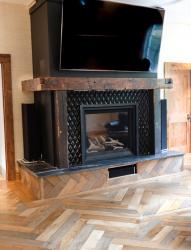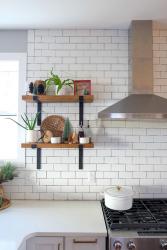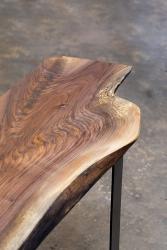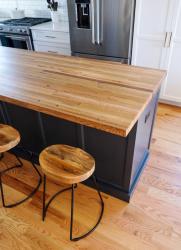Tell us a bit about your background and how it relates to reclaimed materials. My background is in architecture. I moved back to St. Louis in 2009 after spending several years abroad and fell in love with my hometown, but I didn’t like seeing our cool old buildings being crushed and sent to the landfill. I saw a need for more deconstruction, as opposed to demolition, so that salvaged building materials could be reincorporated into our community, creatively!
What motivated you to branch out from salvaging/reclaiming these materials to actually building furniture? Many of our customers see a piece of lumber and have a dream to incorporate it into their home but they lack the tools, or the skill set, to make it happen. Refab Lab was born out of a desire to make our customers’ visions into reality. We also wanted to get the most out of our incredible assortment of reclaimed wood and started out by experimenting with using some of the least desirable pieces, namely old oak 2x4, to make feature wall paneling and butcher block.
How is furniture built out of reclaimed wood different from conventional furniture? Each piece of reclaimed wood has unique character marks such as knots and nail holes that just cannot be replicated, and this fundamentally changes the way it is crafted. Old wood also has a story to tell and we make sure each of our clients know the age and location of the barn or building from which we sourced the lumber used in their table or barn beam mantel. And, unlike conventional furniture that uses virgin lumber, our products are giving wood from trees felled 100 years ago a second life, making for a more sustainable product.
How does Refab Lab stand out from the crowd? Even among the barn wood builder crowd, our products stand out due to our unique philosophy. Reclaimed wood doesn’t need to be rough and rustic, so we go to great lengths to get past the rough, let the old grain speak for itself, and accentuate the “flaws” by filling them in with black for a smooth and refined look. We also excel at coordinating various reclaimed wood elements in new builds and remodeling projects, like making floating kitchen shelves and a mantel to match a butcher block island.
What trends have you been noticing lately? We make A LOT of butcher blocks and wide-plank island tops. Our clients like stone countertops but don’t necessarily want it on every surface in their kitchens, so a reclaimed wood island top easily becomes a statement piece. Another welcome trend is having fewer, or no, wall cabinets in favor of open shelving, which we make from old floor joists.
What are the biggest challenges you face in your field? The biggest challenge we have faced is the two years of research and development spent refining products before formally launching Refab Lab. Our patience paid off though and we now have a strong product line that is time-tested and that we are proud to put our name behind.
What excites you about the future of using reclaimed materials? Some might think that the reclaimed wood look is a trend, and as trends go will eventually fade. Our younger clients are motivated by a desire to buy local, sustainable reclaimed wood products that support a good cause. Besides, if rustic goes out of fashion, we will still be here cranking out timeless designs using smoothed down old boards.
Give us an example of your favorite project you have worked on recently? We made a barn oak island top for a retired interior designer in Town and Country that was 52 inches wide and over twelve feet long. In addition to the cooktop and popup downdraft, the island featured two popup electrical outlets with matching wood caps. It is a stunning piece on navy cabinets surrounded by white base cabinets on both sides.
How can people see more of your products or reach out to you? We have a showroom at 3130 Gravois Avenue that is open to the public! Instagram and Facebook are also great ways to see what’s currently going on in our shop and to view past projects. Refab Lab also offers in-store and onsite design consultations that can be booked through our website.











